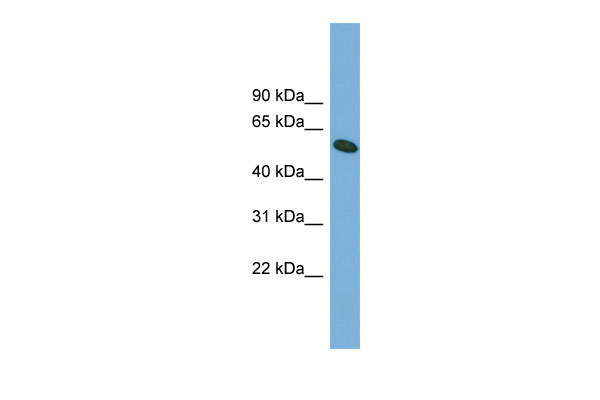OMA1 antibody - middle region
Rabbit Polyclonal Antibody
- 产品详情
- 实验流程
Application
| WB |
|---|---|
| Primary Accession | Q96E52 |
| Other Accession | NM_145243, NP_660286 |
| Reactivity | Human, Mouse, Rat, Rabbit, Zebrafish, Pig, Dog, Guinea Pig, Horse, Bovine, Yeast |
| Predicted | Human, Mouse, Rat, Rabbit, Pig, Chicken, Dog, Guinea Pig, Horse, Bovine |
| Host | Rabbit |
| Clonality | Polyclonal |
| Calculated MW | 60120 Da |
| Gene ID | 115209 |
|---|---|
| Alias Symbol | 2010001O09Rik, DAB1, FLJ33782, MPRP-1, YKR087C, ZMPOMA1 |
| Other Names | Metalloendopeptidase OMA1, mitochondrial, 3.4.24.-, Metalloprotease-related protein 1, MPRP-1, Overlapping with the m-AAA protease 1 homolog, OMA1, MPRP1 |
| Format | Liquid. Purified antibody supplied in 1x PBS buffer with 0.09% (w/v) sodium azide and 2% sucrose. |
| Reconstitution & Storage | Add 50 ul of distilled water. Final anti-OMA1 antibody concentration is 1 mg/ml in PBS buffer with 2% sucrose. For longer periods of storage, store at 20°C. Avoid repeat freeze-thaw cycles. |
| Precautions | OMA1 antibody - middle region is for research use only and not for use in diagnostic or therapeutic procedures. |
| Name | OMA1 {ECO:0000303|PubMed:20038677, ECO:0000312|HGNC:HGNC:29661} |
|---|---|
| Function | Metalloprotease that is part of the quality control system in the inner membrane of mitochondria (PubMed:20038677, PubMed:25605331, PubMed:32132706, PubMed:32132707). Activated in response to various mitochondrial stress, leading to the proteolytic cleavage of target proteins, such as OPA1, UQCC3 and DELE1 (PubMed:20038677, PubMed:25275009, PubMed:32132706, PubMed:32132707). Involved in the fusion of the mitochondrial inner membranes by mediating cleavage of OPA1 at S1 position, generating the soluble OPA1 (S-OPA1), which cooperates with the membrane form (L-OPA1) to coordinate the fusion of mitochondrial inner membranes (PubMed:31922487). Following stress conditions that induce loss of mitochondrial membrane potential, mediates cleavage of OPA1, leading to excess production of soluble OPA1 (S-OPA1) and negative regulation of mitochondrial fusion (PubMed:20038677, PubMed:25275009). Involved in mitochondrial safeguard in response to transient mitochondrial membrane depolarization (flickering) by catalyzing cleavage of OPA1, leading to excess production of S-OPA1, preventing mitochondrial hyperfusion (By similarity). Also acts as a regulator of apoptosis: upon BAK and BAX aggregation, mediates cleavage of OPA1, leading to the remodeling of mitochondrial cristae and allowing the release of cytochrome c from mitochondrial cristae (PubMed:25275009). In depolarized mitochondria, may also act as a backup protease for PINK1 by mediating PINK1 cleavage and promoting its subsequent degradation by the proteasome (PubMed:30733118). May also cleave UQCC3 in response to mitochondrial depolarization (PubMed:25605331). Also acts as an activator of the integrated stress response (ISR): in response to mitochondrial stress, mediates cleavage of DELE1 to generate the processed form of DELE1 (S- DELE1), which translocates to the cytosol and activates EIF2AK1/HRI to trigger the ISR (PubMed:32132706, PubMed:32132707). Its role in mitochondrial quality control is essential for regulating lipid metabolism as well as to maintain body temperature and energy expenditure under cold-stress conditions (By similarity). Binds cardiolipin, possibly regulating its protein turnover (By similarity). Required for the stability of the respiratory supercomplexes (By similarity). |
| Cellular Location | Mitochondrion inner membrane; Single-pass membrane protein {ECO:0000250|UniProtKB:Q9D8H7} |
| Tissue Location | Widely expressed, with strong expression in the heart, skeletal muscle, kidney and liver |
Research Areas
For Research Use Only. Not For Use In Diagnostic Procedures.
Application Protocols
Provided below are standard protocols that you may find useful for product applications.
REFERENCES
Bao Y.-C.,et al.DNA Res. 10:123-128(2003).
Gregory S.G.,et al.Nature 441:315-321(2006).
Mural R.J.,et al.Submitted (SEP-2005) to the EMBL/GenBank/DDBJ databases.
Ota T.,et al.Nat. Genet. 36:40-45(2004).
Head B.,et al.J. Cell Biol. 187:959-966(2009).
终于等到您。ABCEPTA(百远生物)抗体产品。
点击下方“我要评价 ”按钮提交您的反馈信息,您的反馈和评价是我们最宝贵的财富之一,
我们将在1-3个工作日内处理您的反馈信息。
如有疑问,联系:0512-88856768 tech-china@abcepta.com.























 癌症的基本特征包括细胞增殖、血管生成、迁移、凋亡逃避机制和细胞永生等。找到癌症发生过程中这些通路的关键标记物和对应的抗体用于检测至关重要。
癌症的基本特征包括细胞增殖、血管生成、迁移、凋亡逃避机制和细胞永生等。找到癌症发生过程中这些通路的关键标记物和对应的抗体用于检测至关重要。 为您推荐一个泛素化位点预测神器——泛素化分析工具,可以为您的蛋白的泛素化位点作出预测和评分。
为您推荐一个泛素化位点预测神器——泛素化分析工具,可以为您的蛋白的泛素化位点作出预测和评分。 细胞自噬受体图形绘图工具为你的蛋白的细胞受体结合位点作出预测和评分,识别结合到自噬通路中的蛋白是非常重要的,便于让我们理解自噬在正常生理、病理过程中的作用,如发育、细胞分化、神经退化性疾病、压力条件下、感染和癌症。
细胞自噬受体图形绘图工具为你的蛋白的细胞受体结合位点作出预测和评分,识别结合到自噬通路中的蛋白是非常重要的,便于让我们理解自噬在正常生理、病理过程中的作用,如发育、细胞分化、神经退化性疾病、压力条件下、感染和癌症。






